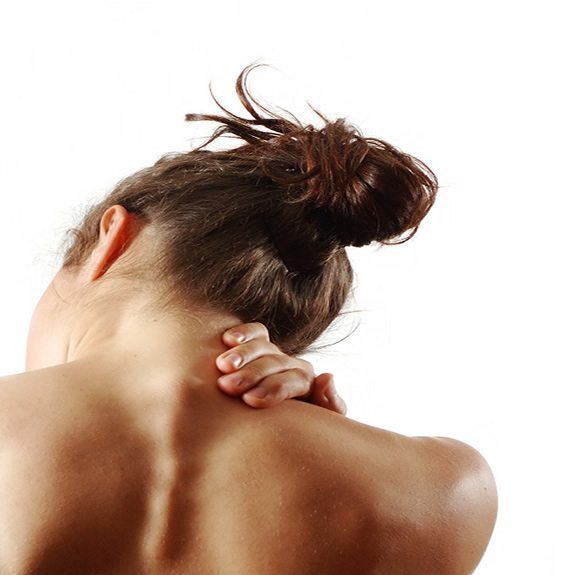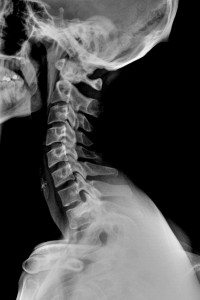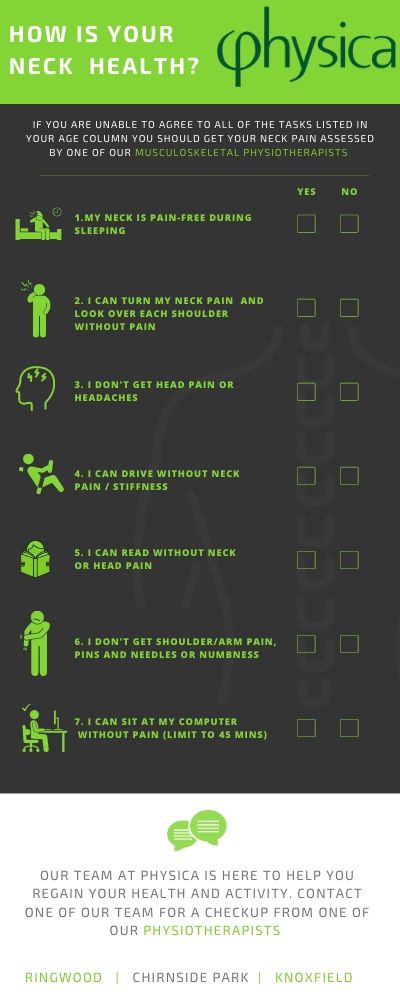Let’s Begin…
The cervical spine or your neck connects the head to the trunk. It is a common source of problems and accounts for pain in 60% of people at some stage of their lives.
Neck pain is often disabling in its nature and results in local pain and sometime refers pain to the head and face area. Neck pain requires a comprehensive assessment and our team are well suited to assist you with this.

In the case of the neck both static and dynamic postures are very important. A comprehensive pillow, workplace or driving assessment is often required to assist in your management.
In the cervical spine the IVD and facet joints are innervated by the same spinal segment, making it difficult to determine whether both structures are implicated as the source of nociception, or, if one structure is sensitised through means of secondary hyperalgesia.
Anatomy of the neck
The cervical spine or neck is comprised of seven vertebrae from C1-C7, muscles, ligaments and discs that enable movement between the vertebrae. The cervical spine controls head and neck movements. We can divide the cervical spine into three zones: the upper,  mid and lower.
mid and lower.
The upper zone (c1-c3) controls the head on neck nodding and rotation. Almost 45 degrees of neck rotation occurs at C1/2 level.
The mid zone assists in general range of motion with each segment C4-c6 allowing 5-7 degrees of neck flexion, extension and lateral flexion.
The lower cervical spine (c6-c7) becomes more rigid and starts to resemble the thoracic vertebrae. In some cases the lower cervical spine vertebrae can have their own ribs. These are called cervical ribs and can sometimes contribute to vascular or neurological issues to the braxial plexus. We have covered one of these conditions, thoracic outlet syndrome.
SIGNS AND SYMPTOMS
- neck pain
- shoulder blade pain
- pins and needles and numbness
- headaches
CONDITIONS
- Whiplash - find out more
- Discogenic Neck Pain
- Acute wry neck- find out more
- Facet Joint Neck Pain
- Chronic Neck Pain
- Headaches- find out more
- Thoracic Outlet Syndrome- find out more
- Nerve root pain- read more
- Neck pain assessment tool- click here
- Pillow assessment tool- click here
GENERAL ADVICE
POSTURAL STRESS: Poor posture stresses your neck. Ligaments are overstretched, muscles tire and joints and nerves can be put under pressure.
WHIPLASH: Motor vehicle accidents and some sporting incidents can place a sudden strain on the neck, leading to a wide range of soft-tissue injuries, known as whiplash. Common symptoms include neck pain, upper back pain and headaches.
ARTHRITIS: Over time, the joints and discs in the neck may degenerate, leading to inflammation and pain. Bony spurs may develop on the edges of the vertebrae.
On rare occasions neck pain can have a more serious underlying cause and if you are worried about any additional or unusual symptoms, discuss this with your physiotherapist or family doctor.
SLEEPING: Your physiotherapist can advise you on the best type of pillow for your neck. Also, avoid sleeping on your front where possible.
AT WORK: Avoid working with your head down or to one side for too long. Frequently stretch and change position.
COMPUTER USE: It is important to have a good posture when using a computer. This will minimise the amount of strain on your neck. Think tall: chest lifted, shoulders relaxed, chin tucked in and head level. Speak to your physiotherapist about proper workstation setup.
RELAXATION: Many people ‘carry’ their stress in their neck and shoulders, leading to hunched shoulders and clenching of the jaw.

To download a pdf version of the screening tool- click here
Need additional help
Our team at Physica are here to help you with all of your musculoskeletal conditions. Please book on;likne using the link in the header or if you have additional questions prior to bookings contact us via email.
